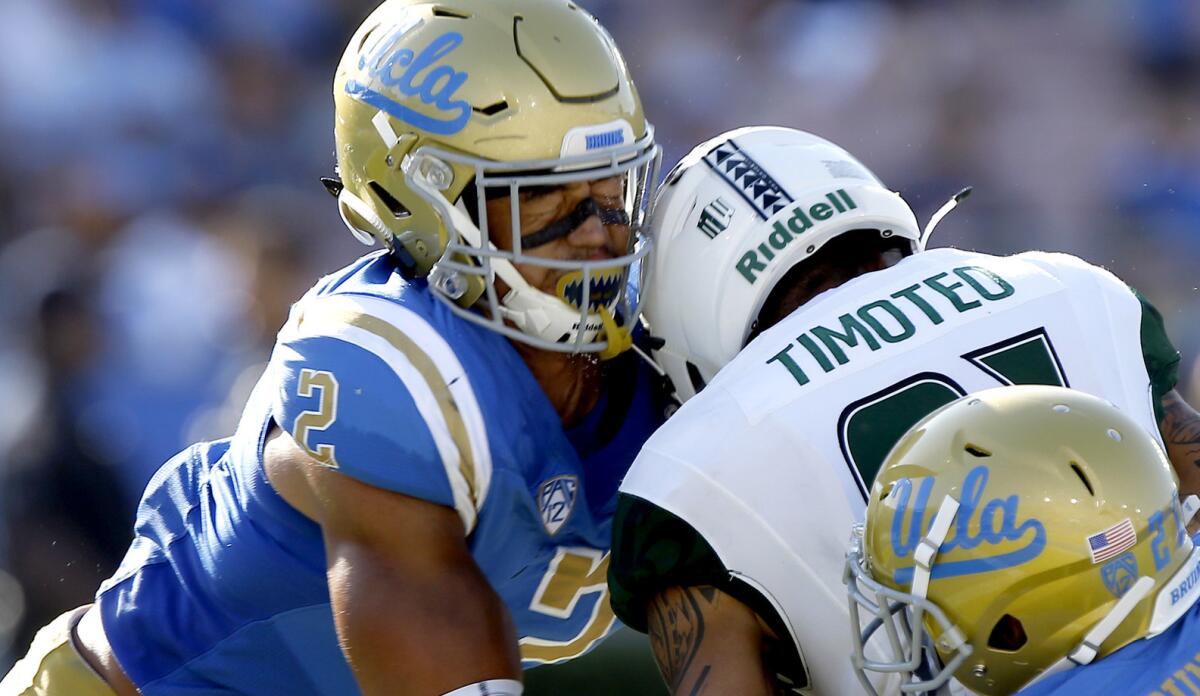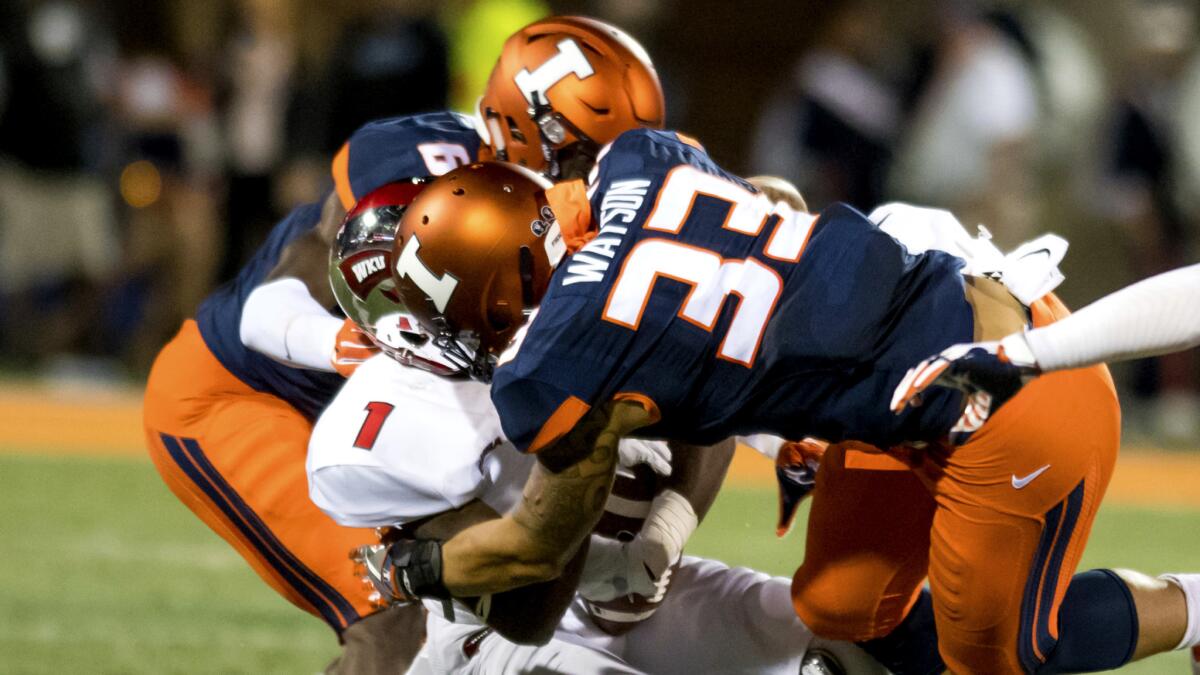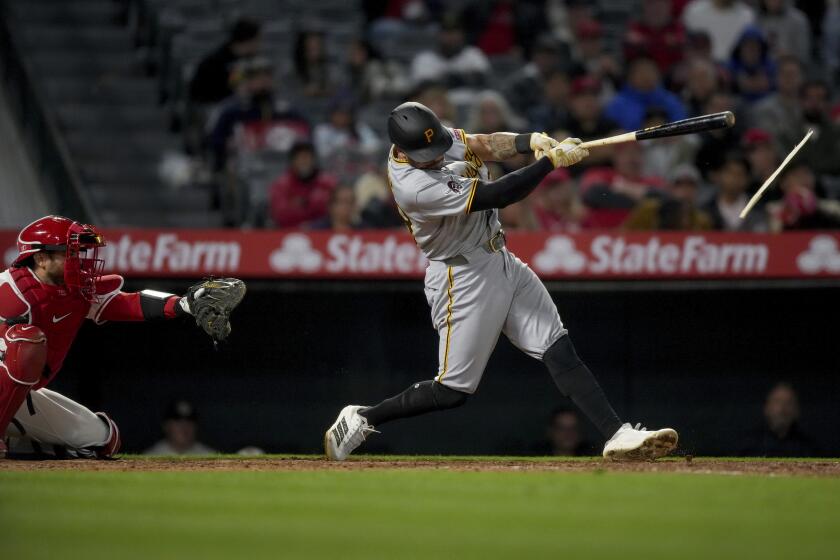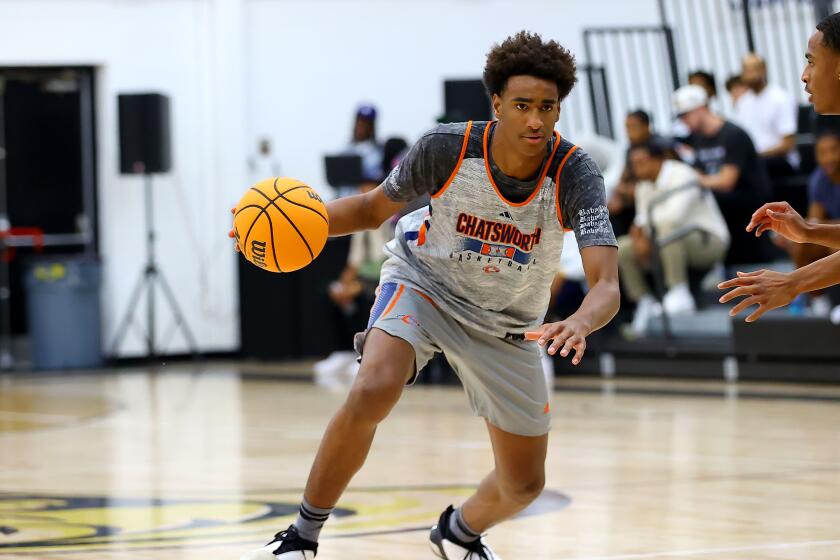The problem with college football’s targeting rule, according to UCLA’s Jim Mora and other coaches and players

- Share via
Jim Mora watched the play and had an identical reaction to that of his son, the UCLA football coach by the same name.
They both saw Bruins safety Adarius Pickett dip his upper body toward Stanford tight end Dalton Schultz’s midsection as Pickett approached to make a tackle.
A moment before impact, Schultz dropped his shoulder and head to protect himself. Pickett then struck him helmet to helmet, resulting in a targeting penalty and Pickett’s ejection.
Father, like son, didn’t see any culpability on the part of the defender.
“He told me the other day, he said, ‘If I was to put together a clinic tape on how to tackle, Adarius Pickett’s would be one of the ones I showed. It was a perfect tackle,’ ” the younger Mora said of his father, a former NFL coach. “And it was a perfect tackle.”
College football installed the targeting rule for safety reasons in 2008, hoping to eliminate what is considered forcible contact to the head or neck. But its application during games — and the stiff accompanying punishment — continue to trouble some coaches and players.
Pickett was ejected during the first quarter of UCLA’s loss to Stanford, with the Bruins allowing 55 points in his absence. Players who are ejected for targeting in the second half of a game must sit out the first half of their team’s next game.
“You [only] get so many opportunities to play the game of football,” Pickett said, “and getting kicked out of the game, especially like that, early, that hurts.”
There are other gripes with the targeting rule. Washington State coach Mike Leach called it “micromanaging, for lack of a better word,” citing too many variables and inconsistent enforcement. Stanford coach David Shaw echoed a sentiment shared by Mora and Pickett: that there should be different levels of targeting penalties corresponding with the severity of the infraction.
“If the offensive player lowers his helmet, hey, great, put the onus on the defensive player and let’s have the 15-yard penalty,” Shaw said. “But let’s leave him in the game because it’s obvious that he’s trying not to hit the guy in the helmet, it just happened incidentally.”
David Coleman, the Pac-12 Conference’s director of officials, said varying levels of targeting penalties was a topic that he expected the NCAA’s rules committee to discuss after this season. Since the issue involves player safety, any rule change could be implemented for the 2018 season.
I see it is changing behavior ... players are being taught and coached to understand that they can make a play without using their head.
— Dave Coleman, Pac-12 Conference director of officials, on targeting rules

This is the second season that replay officials have been allowed to initiate targeting penalties that are not called on the field. Replay officials are also responsible for confirming or overturning targeting calls made during a play.
Coleman said he believes the targeting rule is having its intended effect of making the game safer. The NCAA rule book prohibits both forcible contact with the crown of the helmet and forcible contact to the head or neck of a defenseless player.
“I see that it is changing behavior, and that’s what it’s all about,” Coleman said, “that players are being taught and coached to understand that they can make a play without using their head.”
UCLA has been called for four of the nine targeting penalties upheld against Pac-12 teams this season, according to qwikref.com, an online repository for tracking officials’ calls. Four other targeting penalties against Pac-12 teams were waved off after being reviewed by replay officials.
With the season less than half over, the Pac-12 is on pace to surpass its 16 targeting calls that were upheld in 2016.
Coleman said he didn’t view the potential increase as troubling.
“It’s not a cause for concern per se,” he said. “It is an area of focus in terms of the fact that we really want to do everything we can to call these fouls when they take place.”
UCLA’s Mora disputed two of the targeting calls that went against his team, including the play involving Pickett and one in which linebacker Josh Woods appeared to be turning his body at the last moment in an unsuccessful attempt to avoid helmet-to-helmet contact with a Hawaii receiver.
The Bruins also were involved with a non-call that the Pac-12 later acknowledged should have been ruled targeting against a Hawaii player for helmet-to-helmet contact that popped UCLA linebacker Kenny Young’s helmet off his head before he hit the ground. Young sustained head trauma that sidelined him for the rest of the game as well as the Bruins’ next game against Memphis.
USC is among the Pac-12 teams that have avoided a targeting penalty through the season’s first five games. Trojans coach Clay Helton credited the team’s practice methods.
“Our kids have done a good job of, one, I think being trained to protect themselves as well as others,” Helton said. “Anything to be able to help the safety of our game, I think, is important.”
Remembering to apply the proper techniques in the midst of a game can be difficult. When UCLA defensive lineman Osa Odighizuwa closed in on Memphis quarterback Riley Ferguson last month, he slammed his helmet into Ferguson’s neck area before pushing him to the ground. Odighizuwa was called for targeting and ejected.
Odighizuwa said the Bruins have practiced proper tackling techniques in an effort to make them instinctive.
“The more we drill it, the more natural it will become,” Odighizuwa said, “and you won’t really have to think about it as much and I think that’s what’s going to help a lot, making it a natural thing to aim lower. That’s kind of the point of the rule.”
Pickett learned that sometimes the aiming and contact points can be different, leading to ejections for what otherwise would have been routine football plays.
“We have to accelerate the movement toward a resolution,” UCLA’s Mora said, “because we are hurting young men’s ability to go out and play in games that are important to their future.”
More to Read
Go beyond the scoreboard
Get the latest on L.A.'s teams in the daily Sports Report newsletter.
You may occasionally receive promotional content from the Los Angeles Times.











